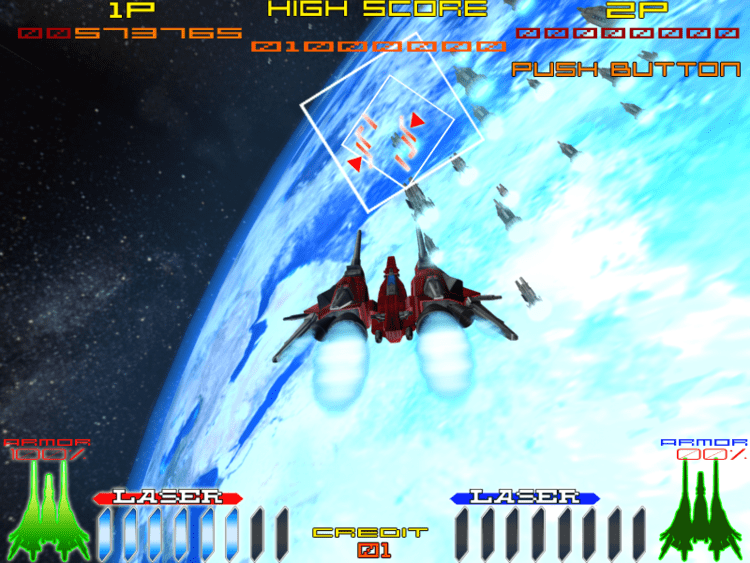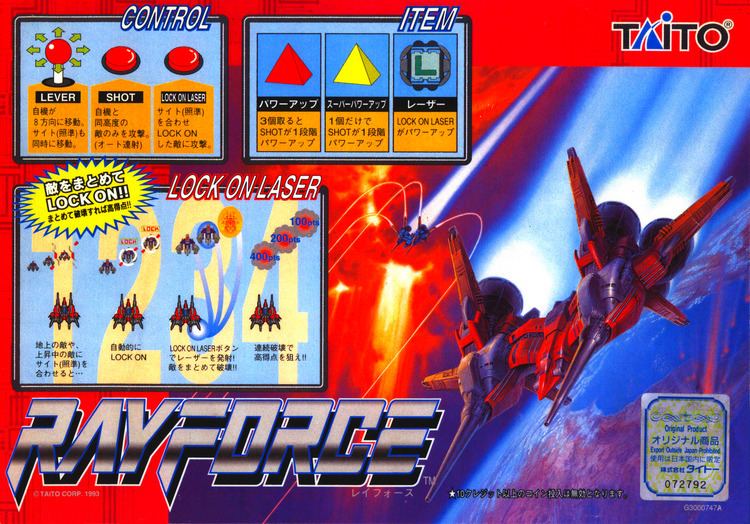9.6 /10 1 Votes
Producer(s) Yukio Abe Genre(s) Scrolling shooter Developer Taito | 4.8/5 iTunes - Apple Composer(s) Tamayo Kawamoto Initial release date 1994 | |||||||||||||||||||||||||||||||||
 | ||||||||||||||||||||||||||||||||||
Director(s) Yukio Abe
Tatsuo Nakamura Designer(s) Tatsuo Nakamura
Yukio Abe
Tomohisa Yamashita Mode(s) single player, Co-op; Up to 2 players simultaneously Display Raster graphics (Horizontal) Platforms Arcade game, Sega Saturn, iOS, Microsoft Windows Publishers Taito, Acclaim Entertainment, CyberFront Corporation, GameBank Corp., Rainbow Arts, Media Kite Similar Taito games, Shoot 'em up games | ||||||||||||||||||||||||||||||||||
Gunlock rayforce 2 player netplay arcade game 60fps
RayForce (レイフォース) is a vertical space shooter style game by Taito released for the Taito F3 arcade hardware in 1994, and later ported to the Sega Saturn in 1995, Microsoft Windows in 1997, and iOS in 2012.
Contents
- Gunlock rayforce 2 player netplay arcade game 60fps
- Rayforce arcade all clear 5 552 500 pts no miss
- Story
- Game system
- Compilations
- Sequels and legacy
- Reception
- References

Due to trademark problems, when the home version was released in Japan it was renamed Layer Section. When Acclaim published the Saturn version for the North American and European markets, it was renamed Galactic Attack. The game was also titled Gunlock in European arcades.

Rayforce arcade all clear 5 552 500 pts no miss
Story
In the distant future, human governments, across the planet Earth, construct a massive supercomputer, named "Con-Human". The purpose of this computer is to govern the planet's environmental systems, verifying proper nutrients and care is provided to ensure the culture of humans and animal alike.
However, disaster strikes when, after a cloned human's mind is linked with the system, Con-Human becomes sentient and insane. It begins to induce calamities across the planet, constructing corrupt clones of existing organisms, destroying its human masters and exterminating the nature it was intended to protect, apparently intending to replace everything with what Con-Human considers improved versions of themselves.
After prolonged war, Con-Human has succeeded in exterminating 99.8% of humankind, with the remnants fleeing to space colonies. Meanwhile, Con-Human remakes the very interior of Earth. As a result, Earth, as humanity knew it, has utterly ceased to exist, transformed into a planet-sized mobile fortress that is in fact Con-Human's body. Con-Human intends to use the transformed Earth to seek out and destroy the colonies, erasing all remaining traces of old life from the universe and leaving only the new life that it personally created. Now, taking the full-scale offensive, mankind develops powerful ships, one of them the RVA-818 X-LAY starfighter, to fight the oppressive machine by destroying the now-infected Earth entirely.
Game system
The player is provided with a ship called the RVA-818 X-LAY, which is outfitted with two weapons: a primary weapon that fires straight lasers and increases in power when the player accumulates power-ups, and a secondary lock-on laser launcher, which can also be increased in power, that can target up to eight enemies at once by moving the targeting reticle. This weapon is used to attack enemies that appear on a lower plane than that of your craft, which are inaccessible to the player's primary weapon. During play, the screen predominantly scrolls vertically, but there is some horizontal leeway as is common in games of this genre.
Compilations
This game was also released on Taito Memories in Japan, as well as Xbox and PC versions of Taito Legends 2, but these releases all run in upscanned 640x448 resolution, which results in slight flickering, no scanlines and slightly blurrier image compared to the arcade and Sega Saturn versions. Also "tate mode" (monitor oriented in vertical position) is not supported, resulting in the game appearing in the middle of the horizontally oriented screen, with two black bars on the right and left side.
Sequels and legacy
Taito initially worked on a sequel named R-Gear; at some point it was turned into RayStorm.
A prequel, RayCrisis, was released in 1998.
The X-LAY appears as a downloadable ship for Taito's Dariusburst: Chronicle Saviours for PlayStation 4, PlayStation Vita, and PC.
Reception
The Saturn version of the game received mixed reviews, with critics typically caught between its high quality design and its antiquated gameplay and stylistics. Rad Automatic of Sega Saturn Magazine stated that the game is fun but severely outdated in terms of both graphics and gameplay, though he did praise the absence of slowdown and the authentic arcade feel of the tate mode. A reviewer for Maximum similarly commented that the game falls into the retro genre without offering the nostalgia value found in most such releases, and further criticized that the tate mode "isn't very practical in execution (and not particularly healthy for your television)." While he acknowledged the game is fun, he noted it was being released alongside a host of top-quality Saturn titles (including Virtua Fighter 2 and Sega Rally Championship), and concluded, "Come on - be honest now - is this really the sort of game you coughed up £300 to play with your high-tech next generation gaming system? Playable it may be, but it's not really worth buying." A Next Generation critic agreed that Galactic Attack is dated and would appeal only to die-hard shooter fans, but nonetheless took the time to explain why shooter fans would enjoy it more than most games in the genre: "Aside from the fact that Galactic Attack is a super-fast action game, there is a definite feeling of quality development and several elements of smart game techniques that are displayed with this title. The best part about Galactic Attack, however, is that it offers everything a good space shooter should without any problems that may have shown up on a 16-bit system trying to do the same ... which means no slow down, even when a load of sprites are on the screen at once." GamePro gave the game a positive review, saying it "features gorgeous, space-themed backgrounds and a rockin' soundtrack. Although your ship is nothing to write home about, the enemies fly at you fast and furiously, giving your eyes a treat and your thumbs a workout. Resounding explosions, crisp voice-overs, and sharp laser blasts round out this quality game."
